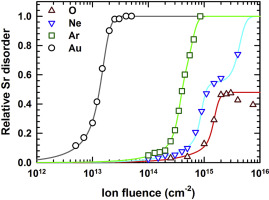当前位置:
X-MOL 学术
›
Acta Mater.
›
论文详情
Our official English website, www.x-mol.net, welcomes your
feedback! (Note: you will need to create a separate account there.)
Revealing ionization-induced dynamic recovery in ion-irradiated SrTiO 3
Acta Materialia ( IF 8.3 ) Pub Date : 2018-05-01 , DOI: 10.1016/j.actamat.2018.02.038 Gihan Velişa , Elke Wendler , Haizhou Xue , Yanwen Zhang , William J. Weber
Acta Materialia ( IF 8.3 ) Pub Date : 2018-05-01 , DOI: 10.1016/j.actamat.2018.02.038 Gihan Velişa , Elke Wendler , Haizhou Xue , Yanwen Zhang , William J. Weber

|
Abstract The lack of fundamental understanding on the coupled effects of energy deposition to electrons and atomic nuclei on defect processes and irradiation response poses a significant roadblock for the design and control of material properties. In this work, SrTiO3 has been irradiated with various ion species over a wide range of ion fluences at room temperature with a goal to deposit different amounts of energy to target electrons and atomic nuclei by varying the ratio of electronic to nuclear energy loss. The results unambiguously show a dramatic difference in behavior of SrTiO3 irradiated with light ions (Ne, O) compared to heavy ions (Ar). While the damage accumulation and amorphization under Ar ion irradiation are consistent with previous observations and existing models, the damage accumulation under Ne irradiation reveals a quasi-saturation state at a fractional disorder of 0.54 at the damage peak for an ion fluence corresponding to a dose of 0.5 dpa; this is followed by further increases in disorder with increasing ion fluence. In the case of O ion irradiation, the damage accumulation at the damage peak closely follows that for Ne ion irradiation up to a fluence corresponding to a dose of 0.5 dpa, where a quasi-saturation of fractional disorder level occurs at about 0.48; however, in this case, the disorder at the damage peak decreases slightly with further increases in fluence. This behavior is associated with changes in kinetics due to irradiation-enhanced diffusional processes that are dependent on electronic energy loss and the ratio of electronic to nuclear energy dissipation. These findings are critical for advancing the fundamental understanding of ion-solid interactions and for a large number of applications in oxide electronics where SrTiO3 is a foundational material.
中文翻译:

揭示离子辐照 SrTiO 3 中电离诱导的动态恢复
摘要 对能量沉积对电子和原子核对缺陷过程和辐射响应的耦合影响缺乏基本的了解,这对材料特性的设计和控制构成了重大障碍。在这项工作中,SrTiO3 已在室温下在很宽的离子通量范围内用各种离子种类进行辐照,目的是通过改变电子与核能损失的比率,将不同数量的能量沉积到目标电子和原子核上。结果明确表明,与重离子 (Ar) 相比,用轻离子 (Ne, O) 照射的 SrTiO3 的行为存在显着差异。虽然Ar离子辐照下的损伤积累和非晶化与先前的观察和现有模型一致,对于对应于 0.5 dpa 剂量的离子注量,Ne 辐照下的损伤积累在损伤峰处显示出 0.54 分数阶无序的准饱和状态;随后随着离子注量的增加,无序度进一步增加。在 O 离子辐照的情况下,损伤峰处的损伤积累与 Ne 离子辐照的损伤积累密切相关,达到对应于 0.5 dpa 剂量的注量,其中分数无序水平的准饱和发生在约 0.48 处;然而,在这种情况下,随着能量密度的进一步增加,损伤峰值处的无序性略有下降。这种行为与由于辐射增强扩散过程而导致的动力学变化有关,该过程依赖于电子能量损失和电子与核能耗散的比率。
更新日期:2018-05-01
中文翻译:

揭示离子辐照 SrTiO 3 中电离诱导的动态恢复
摘要 对能量沉积对电子和原子核对缺陷过程和辐射响应的耦合影响缺乏基本的了解,这对材料特性的设计和控制构成了重大障碍。在这项工作中,SrTiO3 已在室温下在很宽的离子通量范围内用各种离子种类进行辐照,目的是通过改变电子与核能损失的比率,将不同数量的能量沉积到目标电子和原子核上。结果明确表明,与重离子 (Ar) 相比,用轻离子 (Ne, O) 照射的 SrTiO3 的行为存在显着差异。虽然Ar离子辐照下的损伤积累和非晶化与先前的观察和现有模型一致,对于对应于 0.5 dpa 剂量的离子注量,Ne 辐照下的损伤积累在损伤峰处显示出 0.54 分数阶无序的准饱和状态;随后随着离子注量的增加,无序度进一步增加。在 O 离子辐照的情况下,损伤峰处的损伤积累与 Ne 离子辐照的损伤积累密切相关,达到对应于 0.5 dpa 剂量的注量,其中分数无序水平的准饱和发生在约 0.48 处;然而,在这种情况下,随着能量密度的进一步增加,损伤峰值处的无序性略有下降。这种行为与由于辐射增强扩散过程而导致的动力学变化有关,该过程依赖于电子能量损失和电子与核能耗散的比率。











































 京公网安备 11010802027423号
京公网安备 11010802027423号